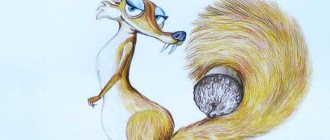Cityscape in pencil
This version of the pencil sketch has more detail, so it requires a more careful approach.
The picture will show a city street with a slight bend and a narrow sidewalk between buildings.
Step-by-step master class.
- First of all, you need to put good markings on a sheet of paper. It is necessary to draw two horizontal lines above and below the middle of the sheet. Then draw two lines on the left side of the sheet, indicating the facades of houses going into the distance. On the right side, mark the foundations of the houses. From above, mark the roof of the corner house with a zigzag.
- Use vertical segments to outline the walls of the objects, mark a doorway on the facade of one of them.
- Draw the roofs of buildings in detail, taking into account perspective.
- Use double segments to mark the edges of the sidewalks. They may converge and diverge a little. This technique allows you to add volume to your sketch.
- Work out the roofs and mark a small canopy at the front of the house on the right side, marking the entrance to the room.
- Draw a low tree on the left side.
- On the right side of the street, near the canopy, you need to depict a couple of tables and chairs of a summer cafe. Design the entrance to the cafe and the canopy.
- In a pencil sketch, small details are very important. Therefore, it is necessary to carefully depict building facades, balconies, windows and doors.
- The sketch can be supplemented with an image of a person, a cat, a flowerpot, or a lamppost. Windows in buildings located at an angle to the viewer are drawn with a slight bevel. Window openings in a house facing the viewer are square or rectangular in shape.
- Having removed the extra lines, the drawing must be shaded, working out the shadows.
You can take the instructions as a basis and depict your own street landscape.
A similar drawing can be colored with pencils, paints or felt-tip pens.
Cityscape in watercolor
An original watercolor sketch with an urban theme can be created by adhering to a few basic rules. It is better to work on a sketch in the open air, this will help to better capture the transitions of shades and the play of light and shadow.
When working on a watercolor image of a city, it is important to know:
- Large objects should be drawn first, details are drawn after the background has dried,
- First they draw light details, then they begin to depict dark objects.
Step-by-step master class.
- Having chosen a suitable nature, first of all, the largest objects are depicted on a sheet of paper: light walls of houses and dark greenery in the background.
- Space is easy to convey through a play of shades: the foreground shadow is darker than the one in the distance.
- When working with watercolors, there is no need to carefully paint small details. The image may be a little blurry.
- Doors and window openings can be easily marked with light strokes, simply by marking them.
- The leaves of the trees, the umbrella of a street cafe, a child playing on the street are also not drawn in detail, but are outlined with light strokes.
- Some foreground details can be highlighted, giving the design some definition: a lamppost, a curb, or a sidewalk tile. This will help make the sketch more expressive.
If you wish, you can draw the city with a simple pencil and give it expressiveness using shading. It is better to create delicate watercolor sketches directly on the street, where it is easier to capture the dynamics of city life and the special atmosphere. Each corner of the city has its own special mood, which is important to convey on paper.
City crossroads
You can get a completely different picture by making two vanishing marks along the edges of the sketch.
Step-by-step master class.
- On both sides of the sheet, mark the middle with dots.
- Mark the middle of the sheet at the top and bottom with dots, stepping back a small distance from the edge.
- Connect the dots with light lines.
- The protruding corner in the middle of the sheet is the corner of the building in the foreground. It must be highlighted with vertical segments.
- Stepping back a little from the first object, mark the walls of the following buildings. Their roofs will be slightly lower than those in the foreground. The outlines of the roofs are drawn to the vanishing points.
- Objects can be depicted at different heights.
- Architectural elements are outlined and drawn on the facades.
- Stepping back a little from the foundation of the central building, mark the location of the sidewalk. Connect the label to the vanishing points and select the edge of the sidewalk.
- Erase unnecessary marking details.
- Draw details of building facades and do shading.
- Use darker shading to mark the side walls of buildings, creating a shadow from neighboring buildings.
- In the distance, the shading will also be slightly darker than in the foreground.
If desired, the drawing can be supplemented with the image of trees or lanterns. Building facades can easily be supplemented with store signs.
You can practice preliminary marking of a sketch by taking templates of brochures from children's coloring books as a model.
Children's drawing competition "My City" - Irkutsk - a child-friendly territory
Children's drawing competition "My City" dedicated to the 80th anniversary of the Irkutsk region
Age group 6-8 years
Voting in the “Younger Age Group” nomination
- Milana Balabanova, 6 years old 29%, 574 votes
574 votes 29%
574 votes - 29% of all votes
- Usov Dmitry, 7 years old 23%, 456 votes
456 votes 23%
456 votes - 23% of all votes
- Svetlana Varenko, 7 years old 16%, 313 votes
313 votes 16%
313 votes - 16% of all votes
- Shalashov Pavel, 7 years old 15%, 296 votes
296 votes 15%
296 votes - 15% of all votes
- Stovba Kirill, 7 years old 13%, 252 votes
252 votes 13%
252 votes - 13% of all votes
- Novopashin Fedor, 6 years old 2%, 34 votes
34 votes 2%
34 votes - 2% of all votes
- Kokonova Diana, 6 years old 1%, 26 votes
26 votes 1%
26 votes - 1% of all votes
- Senokosov Dmitry, 8 years old 1%, 25 votes
25 votes 1%
25 votes - 1% of all votes
- Mukhametshina Anfisa, 8 years old 1%, 24 votes
24 votes 1%
24 votes - 1% of all votes
Total votes: 2000
Votes: 1421
April 26, 2022 – May 10, 2017
Poll closed
Poll Options are limited because JavaScript is disabled in your browser.
Age group 9-12 years
Voting in the “Middle Age Group” nomination
- Evdokimov Valery, 11 years old 31%, 214 votes
214 votes 31%
214 votes - 31% of all votes
- Makarenko Olga, 12 years old 29%, 201 votes
201 votes 29%
201 votes - 29% of all votes
- Chernykh Arina, 12 years old 13%, 89 votes
89 votes 13%
89 votes - 13% of all votes
- Luchenkova Victoria, 11 years old 10%, 73 votes
73 votes 10%
73 votes - 10% of all votes
- Evgeniy Chekhovich, 9 years old 5%, 38 votes
38 votes 5%
38 votes - 5% of all votes
- Tishkov Ruslan, 11 years old 4%, 26 votes
26 votes 4%
26 votes - 4% of all votes
- Tyurmenko Maxim, 9 years old 4%, 25 votes
25 votes 4%
25 votes - 4% of all votes
- Gusikhin Artem, 11 years old 3%, 18 votes
18 votes 3%
18 votes - 3% of all votes
- Napolov Ivan, 11 years old 2%, 17 votes
17 votes 2%
17 votes - 2% of all votes
Total votes: 701
Votes: 460
April 26, 2022 – May 10, 2017
Poll closed
Poll Options are limited because JavaScript is disabled in your browser.
Age group 13-15 years
Voting in the category “Senior age group”
- Vanteev Grigory, 15 years old 33%, 421 votes
421 votes 33%
421 votes - 33% of all votes
- Mineev Alexander, 14 years old 30%, 377 votes
377 votes 30%
377 votes - 30% of all votes
- Banshchikova Tatyana, 13 years old 10%, 132 votes
132 votes 10%
132 votes - 10% of all votes
- Milyaeva Liya, 15 years old 10%, 122 votes
122 votes 10%
122 votes - 10% of all votes
- Prigarina Yulia, 14 years old 4%, 52 votes
52 votes 4%
52 votes - 4% of all votes
- Belomestnova Valentina, 14 years old 3%, 36 votes
36 votes 3%
36 votes - 3% of all votes
- Alexey Bogdanov, 14 years old 2%, 24 votes
24 votes 2%
24 votes - 2% of all votes
- Azakhova Valeria, 15 years old 2%, 21 votes
21 votes 2%
21 votes - 2% of all votes
- Ireskina Alina, 15 years old 2%, 19 votes
19 votes 2%
19 votes - 2% of all votes
- Smirnov Ivan, 15 years old 2%, 19 votes
19 votes 2%
19 votes - 2% of all votes
- Postnikov Anatoly, 14 years old 1%, 18 votes
18 votes 1%
18 votes - 1% of all votes
- Alexey Vasiliev, 13 years old 1%, 18 votes
18 votes 1%
18 votes - 1% of all votes
Total votes: 1259
Votes: 1058
April 26, 2022 – May 10, 2017
Poll closed
Poll Options are limited because JavaScript is disabled in your browser.
irkdetstvo.ru
Sketching houses from the foreground
From the left side to the support point, draw several vertical lines to indicate the position of multi-story buildings. If you are an experienced enough artist, you can easily do this by hand.
For beginners, we recommend using a ruler. Be sure to ensure that the lines of the houses are perpendicular to the edges of the sheet.
Do the same manipulations on the right side. The top and bottom of the buildings should coincide at the central reference point of the vault. You shouldn’t draw a lot of buildings at once; two or three will be enough, and add the rest in the process of subsequent work. The main thing is to maintain harmony.
Background
Buildings located in the background should be smaller than those in front. The tallest buildings will look good here. Draw sidewalks and walkways between buildings.
Final stage
- Next, we draw the road by drawing two lines from the support point down the sheet at a slight angle. Draw a dividing strip on it.
- Turn the arch point into a light source - a small moon or sun.
- All that remains is to shade each element. Areas should be better shaded in areas that are further away from the light source.
This pencil sketch can later be painted over in different colors. It will be a wonderful coloring book for your children.
Materials
The selection of materials depends on the technique and image style. We recommend starting with a simple black pencil. With its help, it will be easier for you to start mastering other areas.
Subsequently, you can use different colors to apply paint. Other tools you will need are gel pens, watercolors, paper and a ruler.







